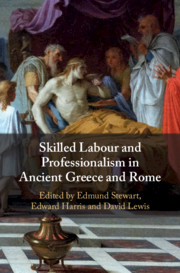Book contents
- Skilled Labour and Professionalism in Ancient Greece and Rome
- Skilled Labour and Professionalism in Ancient Greece and Rome
- Copyright page
- Contents
- Illustrations
- Contributors
- Acknowledgements
- Abbreviations
- Introduction
- Part I Professionals and Professional Identity in Greece and Rome
- Part II Specialization and the Division of Labour in the Ancient City
- 4 Labour Specialization in the Athenian Economy: Occupational Hazards
- 5 The Perception of ‘Skills’ in Ostia: The Evidence of Monuments and Written Sources
- Part III Case Studies of Professions 1: Sculpture
- Part IV Case Studies of Professions 2: Music and Athletics
- Part V Case Studies of Professions 3: A Profession of Arms?
- Index
- References
5 - The Perception of ‘Skills’ in Ostia: The Evidence of Monuments and Written Sources
from Part II - Specialization and the Division of Labour in the Ancient City
Published online by Cambridge University Press: 18 September 2020
- Skilled Labour and Professionalism in Ancient Greece and Rome
- Skilled Labour and Professionalism in Ancient Greece and Rome
- Copyright page
- Contents
- Illustrations
- Contributors
- Acknowledgements
- Abbreviations
- Introduction
- Part I Professionals and Professional Identity in Greece and Rome
- Part II Specialization and the Division of Labour in the Ancient City
- 4 Labour Specialization in the Athenian Economy: Occupational Hazards
- 5 The Perception of ‘Skills’ in Ostia: The Evidence of Monuments and Written Sources
- Part III Case Studies of Professions 1: Sculpture
- Part IV Case Studies of Professions 2: Music and Athletics
- Part V Case Studies of Professions 3: A Profession of Arms?
- Index
- References
Summary
The prosperous harbour town of Ostia in the second and third centuries AD is a good example for demonstrating the areas of daily life and economic activities, and skilled individuals and professionals. One can expect a very distinctive society, with lots of merchandising activities to fulfil the needs and requirements of the people who lived and worked in the city. Inscriptions, reliefs and mosaics inform us about many occupations and skilled professions, as well as guilds and club houses in Ostia. The aim of the contribution is to discuss evidences of monuments and written sources on skilled professionalism in Ostia exemplarily. In general, the individuals represented themselves in an appropriate manner and in their professional environment.
Keywords
- Type
- Chapter
- Information
- Skilled Labour and Professionalism in Ancient Greece and Rome , pp. 175 - 202Publisher: Cambridge University PressPrint publication year: 2020



